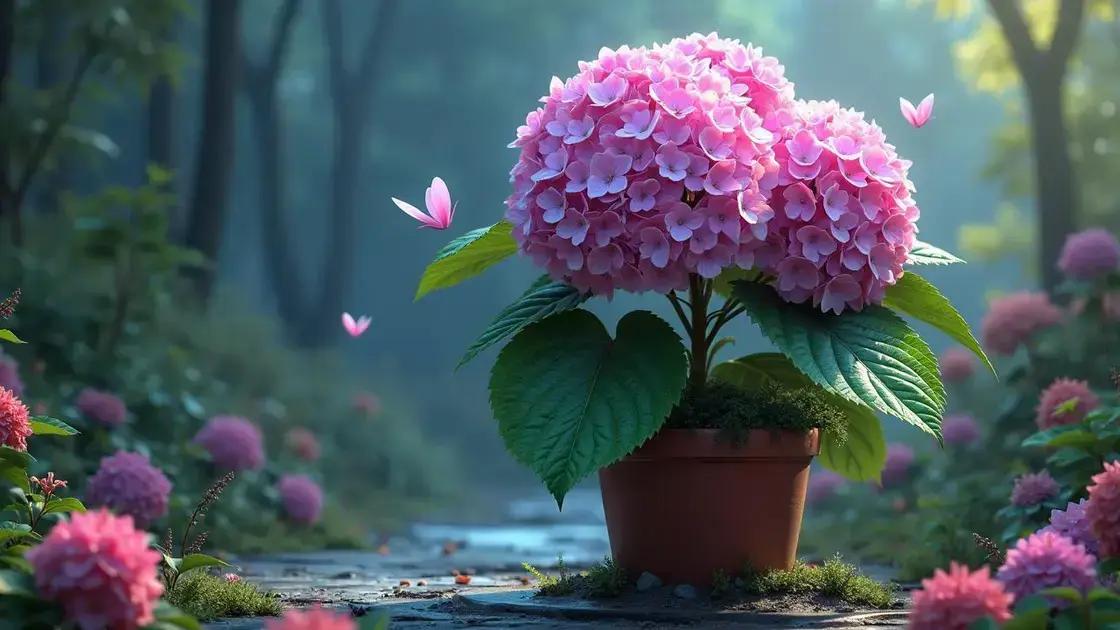How to Care for a Hydrangea Plant in a Pot: 7 Essential Tips
How to care for a hydrangea plant in a pot can be a rewarding journey filled with color and beauty. Picture lush foliage and stunning blooms gracing your garden or patio. Learning the essentials of container gardening will not only nurture your hydrangea but transform your spaces. Dive into the best practices for keeping your potted hydrangea thriving.
Table of Contents
ToggleUnderstanding the watering schedule for hydrangea plants in pots
Understanding the watering schedule for hydrangea plants in pots is essential for keeping your beautiful plants healthy. These beloved flowering plants thrive with the right amount of moisture. A well-planned watering routine can significantly impact their growth and blooming.
Key factors for watering hydrangeas in pots
- Soil moisture: Hydrangeas prefer well-draining soil that allows excess water to escape.
- Temperature: Hot weather can increase the evaporation of moisture, requiring more frequent watering.
- Humidity: The surrounding humidity can influence how often you need to water.
Watering tips for your potted hydrangeas
- Check soil moisture regularly: Stick your finger into the soil about an inch deep. If it feels dry, it’s time to water.
- Water deeply: Ensure the water reaches the root zone by saturating the soil until water drains from the bottom of the pot.
- Adjust based on climate: During dry spells, you may need to water your hydrangeas more frequently, while rainy periods may require less.
Signs your hydrangea needs water
- Wilting leaves: Leaves appear droopy, indicating thirst.
- Discoloration: Yellowing leaves may signal both over-watering and under-watering, so check the soil.
- Dry soil: If the top inch of soil is bone dry, it’s time to water.
Maintaining a consistent watering schedule
Typically, hydrangeas in pots require watering at least once a week. However, adjust your frequency based on seasonal changes and monitor your plant’s needs. During the blooming season, they may require more water to support their vibrant flowers.
Benefits of a proper watering schedule
| Benefit | Description |
|---|---|
| Enhanced blooming | Sufficient water helps maintain healthy flowers and vibrant colors. |
| Stronger growth | A proper watering schedule promotes root development and plant resilience. |
| Pest prevention | Healthy, hydrated plants are less vulnerable to pest infestations. |
For more comprehensive tips on maintaining a thriving indoor garden, consider exploring indoor gardening techniques.
If you keep your potted hydrangeas well-watered and nourished, their beauty will shine bright throughout the growing season!
Soil requirements for growing hydrangeas in containers

Soil requirements for growing hydrangeas in containers are crucial for the health of your plants. Selecting the right soil blend ensures that your hydrangeas thrive in a pot. Proper soil not only provides essential nutrients but also affects drainage, aeration, and moisture retention.
Key characteristics of potting soil for hydrangeas
- Well-draining: Hydrangeas dislike soggy roots, so the soil must allow excess water to escape.
- Moisture retention: While drainage is essential, the soil must still retain enough moisture.
- pH balance: Hydrangeas prefer slightly acidic to neutral soil, ideally between 5.5 and 7.0 for optimal growth.
Best practices
It is advisable to use a potting mix specifically formulated for acid-loving plants or to amend your potting soil with organic materials such as peat moss or compost.
Optimal sunlight exposure for potted hydrangeas
Optimal sunlight exposure for potted hydrangeas is essential for their overall health and blooming potential. These beautiful plants thrive optimally with the right amount of light—not too much and not too little. Understanding their sunlight needs can help you create an ideal environment for your potted hydrangeas.
Understanding light requirements for hydrangeas
- Partial shade: Hydrangeas generally prefer partial shade, especially in hotter climates, which protects them from scorching.
- Morning sun: Morning sunlight is best, as it provides warmth and helps dry dew, reducing the risk of disease.
- Avoid direct midday sun: Intense afternoon sun can cause wilting and sunburn.
Choosing the right location for your hydrangeas
- Evaluate your space: Examine where you plan to place your pots, considering surrounding structures and trees that may cast shade.
- Monitor sunlight patterns: Take note of how sunlight moves across the area throughout the day.
- Adjust based on growth: If your hydrangeas appear leggy or are not blooming well, consider moving them to a sunnier location.
Signs of improper sunlight exposure
- Leggy growth: Stretched stems indicate your hydrangea is searching for more light.
- Sunburned leaves: Brown, crispy leaf edges can signal too much direct sunlight exposure.
- Faded blooms: Lack of vibrant color can suggest insufficient sunlight.
Enhancing sunlight exposure indoors
| Method | Description |
|---|---|
| Rotate pots | Rotate your pots regularly to ensure all sides receive equal sunlight. |
| Use grow lights | If natural light is limited, consider using LED grow lights to supplement. |
For further insights on nurturing indoor plants, check out exploring indoor gardening techniques that can enhance your growing experience. With the right sunlight exposure, your potted hydrangeas can thrive and reward you with stunning blooms all season long.
In conclusion
Caring for potted hydrangeas is a rewarding experience that requires attention to detail in several areas, including watering, soil quality, and sunlight exposure. By following the essential tips outlined in this post, you can ensure that your hydrangeas thrive beautifully in their containers.
Optimal attention to their watering schedule, selecting the right soil mix, and placing them in suitable sunlight will enhance their growth and blooming potential. Don’t forget to constantly observe their needs and adjust care practices as necessary. For more insights on maximizing your indoor gardening efforts, check out tips on enhancing your indoor garden.

